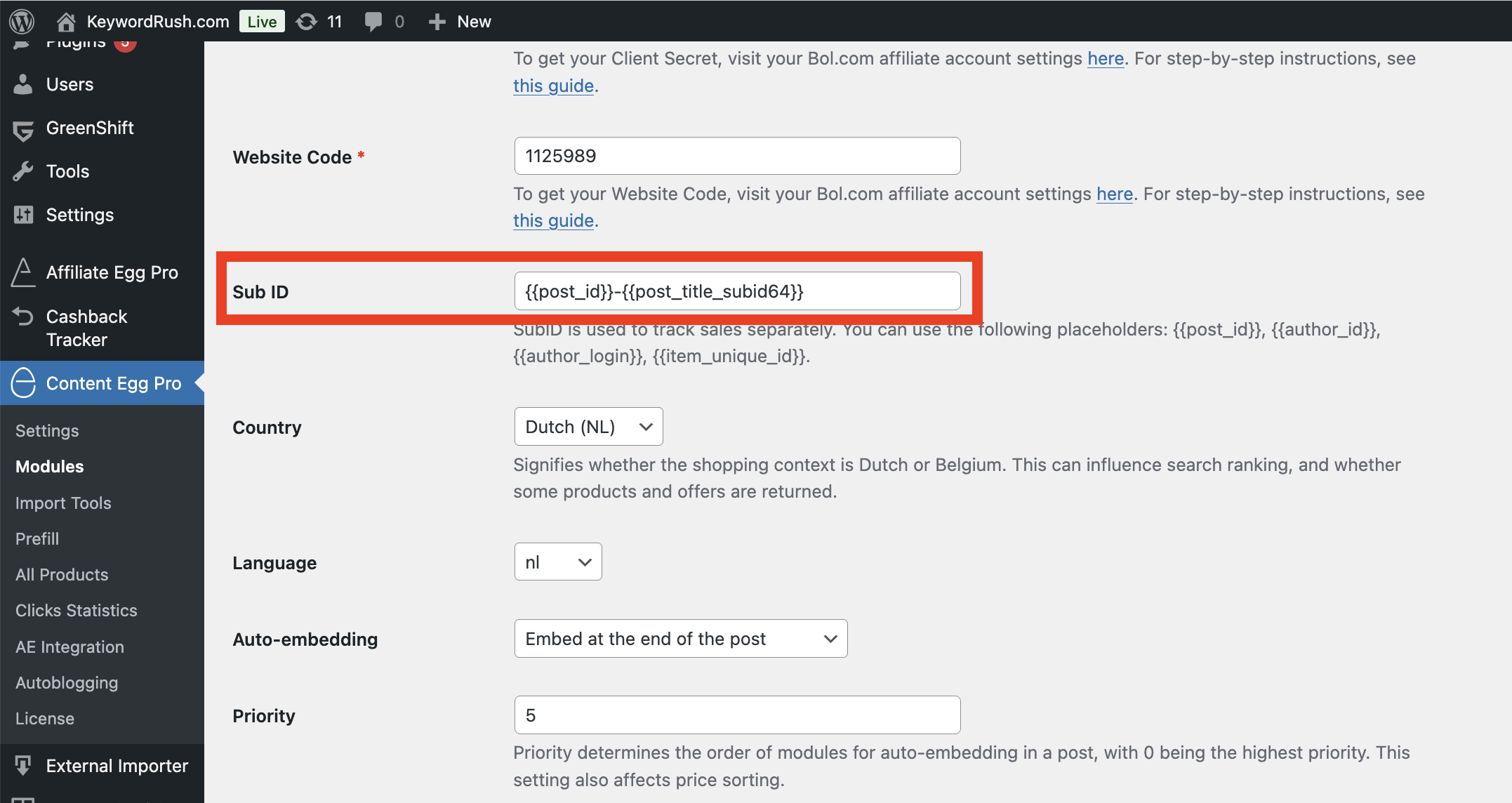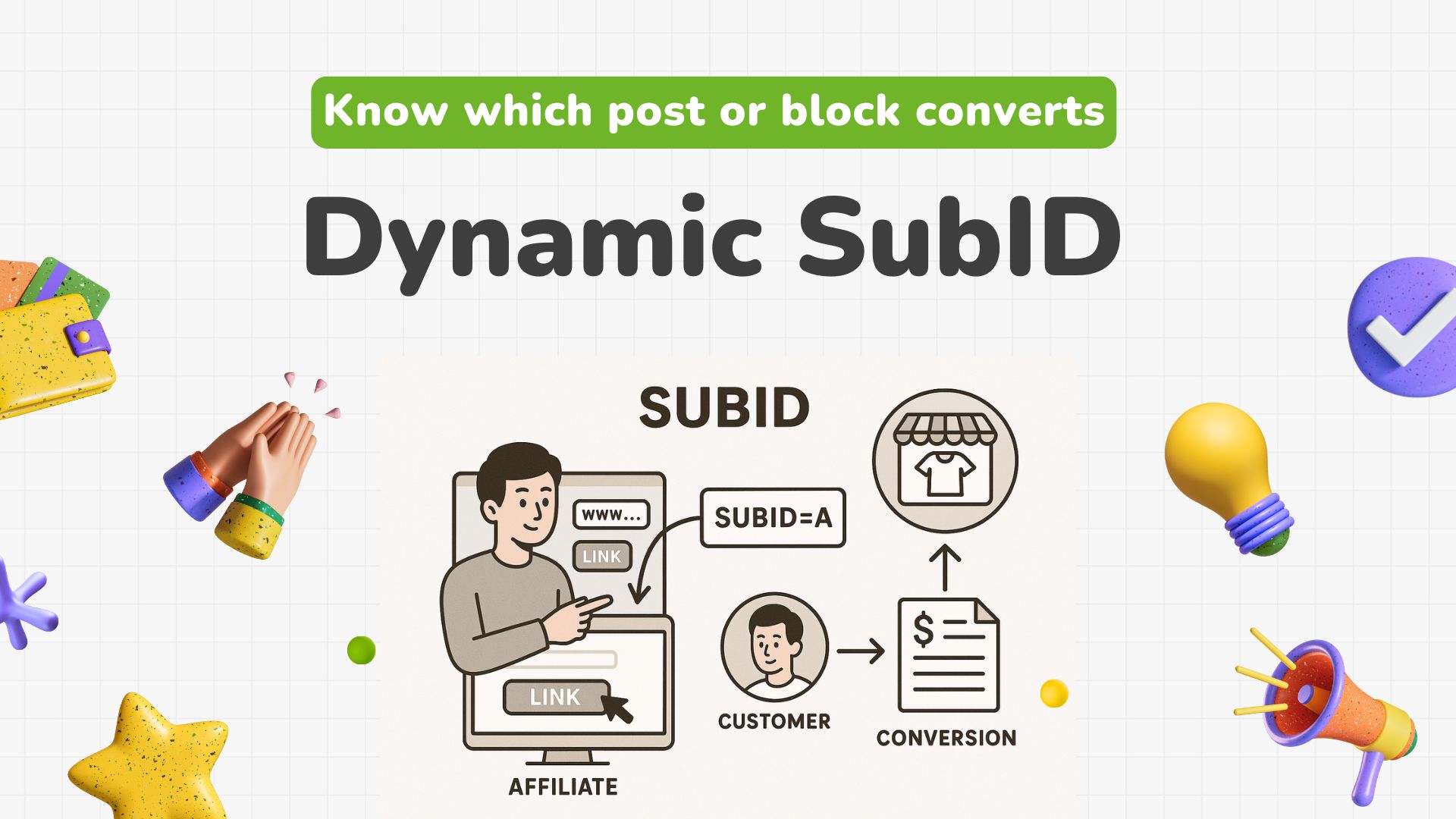What is a SubID?
A SubID is a custom tracking value you append to your affiliate link so you can identify which click (ad, page, placement, author, keyword, etc.) led to a conversion. Think of it as your label for the click—saved by the network and returned in reports or postbacks.
Content Egg automatically adds safe, dynamic SubIDs to every product link—so you always know which post, block, or product made the sale. No extra setup, no messy URLs—just precise insights and cleaner reports, right out of the box.
Definition & common synonyms
Different networks and trackers call the field by different names. They all serve the same purpose: carry your metadata through the click → conversion flow.
| Concept | Typical names you’ll see |
|---|---|
| Single free-form SubID | subid, sub_id, sub, sid, aff_sub |
| Multiple slots (granular) | sub1, sub2, sub3, sub4, sub5 |
| Network-specific aliases (examples) | Awin clickref, CJ sid, Rakuten u1, ShareASale afftrack, Impact subId1–subId5, TUNE/HasOffers aff_sub(1–5), Tradedoubler epi/epi2, Partnerize clickref |
You’ll map your own labels (e.g., post, placement, creative) into whichever parameter name the network expects.
Where it “lives” (in the URL)
SubIDs are added as query parameters on your affiliate deeplink. They can be attached directly to a network link or inside a redirect/url parameter when the link wraps a destination URL.
Direct example
https://track.network.com/click?affid=12345&subid=review-page_topWrapped/redirect example
https://track.network.com/click?affid=12345&subid=review-page_top
&url=https%3A%2F%2Fmerchant.com%2Fproduct%3Fsku%3DABC
Multi-slot example
https://example.hasoffers.com/aff_c?offer_id=9&aff_id=101
&aff_sub=blog
&aff_sub2=airfryer_roundup
&aff_sub3=hero_block
&aff_sub4=creativeA
&aff_sub5=item123
Rule of thumb: URL-encode values (especially if you pass spaces, slashes, or long strings) and keep them short, safe, and non-PII.
Who uses SubIDs (and why)
- Affiliates & publishers
Tie earnings back to content: which post, comparison table, or product made the sale. - Media buyers & performance marketers
Track channel, campaign, ad set, creative, and placement to optimize bids and budgets. - SEOs & content teams
Attribute conversions to authors, templates, schemas, or internal links to guide editorial strategy. - Data/analytics folks
Join SubID values with BI tools, detect anomalies (fraud, broken funnels), and build segment-level profit views.
Quick mental model
- You choose the label →
sub1=channel,sub2=post,sub3=placement, etc. - The network stores it on click.
- Reports/postbacks return it on conversion so you can see what worked—and do more of it.
Why SubIDs Matter
SubIDs turn every click into a measurable unit you can analyze, test, and improve—without guesswork.
Track the right thing
Use a simple SubID schema:
| Slot | What to track | Example value |
|---|---|---|
sub1 | Website | kitchenhub |
sub2 | Post | best-air-fryers or p_4821 |
sub3 | Block / Placement | hero, table_row_1, sidebar_top |
sub4 | Product | ean_590123 / sku_af123 |
sub5 | Author/Editor | author_jlee |
This answers—in every report—which site, which post, which exact block, which product, and which author/editor drove the conversion.
SubID vs. UTM vs. ClickID
These three are complementary—not interchangeable.
| Aspect | SubID | UTM | ClickID |
|---|---|---|---|
| Primary audience | Affiliate network / tracker | Web analytics (e.g., GA4) | The network/program itself |
| Who sets it | You (publisher/marketer) | You (publisher/marketer) | Network (auto-generated) |
| Purpose | Carry your custom context to conversion (post, placement, creative, etc.) | Attribute traffic in analytics tools (source/medium/campaign) | Deterministic attribution key used by network/postbacks |
| Typical names | subid, sub1–sub5, sid, clickref, etc. | utm_source, utm_medium, utm_campaign, utm_term, utm_content | clickid, cid, transaction_id (varies) |
| Lives in | Affiliate deeplink (query params) | Destination URL (visible to analytics) | Stored by network; often echoed back on conversion |
| Paid on? | Yes—used in conversion-side reports | No—analytics only | Drives attribution; critical for payout accuracy |
When to use which
- Use SubIDs to answer what exactly converted (post/placement/creative/author…).
- Use UTMs to understand traffic acquisition in GA4 (source/medium/campaign/keyword).
- Preserve ClickID to ensure the network can match conversion to the right click.
Content Egg: Dynamic SubIDs
Content Egg helps you add product blocks, lists, and price comparison tables to posts—sourcing offers from many affiliate modules (Awin, Bol.com, Linkwise, TradeTracker, eBay, feeds, and more), and rendering them via templates and shortcodes. Every one of those clicks can carry a SubID so you know which website → post → block → product drove the sale.
Where you can use SubIDs in Content Egg
You can insert SubIDs anywhere Content Egg asks for a SubID or a deeplink:
- Module settings (built-in SubID fields): when a network/program supports it (e.g., Awin, Bol.com, Linkwise, TradeTracker, eBay, Feed modules), put your SubID pattern directly into the module’s SubID.
- Deeplink settings: include SubID as part of the deeplink URL.
- Directly in shortcodes: add or override parameters inline using the
add_query_argattribute to stamp SubIDs per block/placement.

Dynamic placeholders: auto-compose SubIDs
Instead of hard-coding values, use dynamic placeholders to build SubIDs from the live post, product, and site context. Wrap placeholders in {{ ... }}—they resolve at render time. Examples: {{post_id}}, {{item_unique_id}}, {{post_url_encoded}}, {{site_domain}}.
Supported placeholder families (examples)
- Basic:
{{url}},{{url_encoded}},{{url_base64}}, plus{{post_id}},{{item_unique_id}}. - Product:
{{item_title}},{{item_brand}},{{item_sku}},{{item_ean}},{{item_upc}},{{item_isbn}},{{item_module_id}},{{item_domain}}. - Page/Post:
{{post_title}},{{post_slug}},{{post_url}},{{post_url_relative}},{{post_author}},{{post_date}}. - Time/Utility:
{{date}},{{timestamp}},{{uuid}},{{post_hash}}.
Safe variants (recommended)
Many networks restrict characters/length. Use automatic variants to keep things valid:
- Generic transforms:
{{..._encoded}},{{..._base64}},{{..._slug}}. - SubID-safe transforms (best for network limits):
{{..._subid}}(≤100 chars),{{..._subid64}}(≤64),{{..._subid32}}(≤32). If truncation happens, a short hash keeps values stable.
Per-block overrides via shortcode
- Identify the parameter your network expects (e.g.,
clickref,sid,u1,afftrack). - In your Content Egg shortcode, add
add_query_arg="PARAM=VALUE&PARAM2=VALUE2". - Compose
VALUEwith placeholders and safe variants (e.g.,{{post_slug_subid}},{{item_sku}}). - Test a click and confirm the SubID appears in the network’s click/conversion report.
Example (Awin-style clickref):
[content-egg module=Awin template=grid add_query_arg="clickref={{post_id}}-{{item_unique_id}}"]
Amazon note (important)
Amazon Associates doesn’t support SubIDs. Instead, use Tracking IDs and assign different tags per site / section / campaign. You can set the tag via shortcode, e.g.:
[content-egg module=Amazon add_query_arg="tag=YOUR_TAG"]
Create/rotate tags to maintain visibility by section without relying on SubIDs.
Tips
- Prefer
{{..._subid}}/{{..._subid32}}variants for network-safe, compact values. - Always URL-encode the merchant destination when it’s passed as a parameter.
- Test clicks in your network to verify SubIDs appear as expected; some programs trim or reject characters.
Master Table — SubID Support in Affiliate Networks & Programs
| Network / Program | SubID Parameter(s) | Max Length | Allowed Characters | SubID Support & Notes |
|---|---|---|---|---|
| Admitad | subid, subid1–subid4 | 50–120 chars | Letters, digits, symbols | Yes – Supports 5 SubIDs. Each up to 50 chars (SubID4 up to 120). Wide character support including Latin/Cyrillic. |
| Adtraction | epi | 128 chars | Alphanumeric | Yes – Single SubID (EPI) supported. |
| Affiliate Future (UK) | tracking | – | Alphanumeric | Yes – Single SubID supported (tracking code). |
| Awin | clickref, clickref2–clickref6 | 50 chars each | ASCII | Yes – Supports up to 6 SubIDs. Each 50 chars. |
| AvantLink | ctc | 64 chars | Alphanumeric | Yes – Single SubID (custom tracking code). |
| Bol.com Partner Program | subid | – | Alphanumeric | Yes – Single SubID supported. Commonly used for campaign or post IDs. |
| CAKE (Platform) | s1–s5 | 100 chars each | ASCII | Yes – Supports 5 SubIDs. Each up to 100 chars. |
| CityAds | sa–sa5 | – | Alphanumeric | Yes – Supports 5 SubIDs for custom tracking. |
| CJ Affiliate (Commission Junction) | sid | 64 chars | ASCII | Yes – Single SubID supported. |
| ClickBank | tid | 100 chars | Alphanumeric | Yes – Single SubID (tracking ID). |
| ClixGalore | OID | – | Alphanumeric | Yes – Single SubID supported. |
| Coupang Partners | subId | – | Alphanumeric | Yes – Single SubID supported. Common for advanced tracking. |
| Daisycon (NL/BE) | ws, ws2, ws3 | 100 / 50 / 50 chars | Alphanumeric + symbols | Yes – Supports 3 SubIDs. Allows various characters including punctuation. |
| eBay Partner Network | customid | – | Alphanumeric | Yes – Single SubID supported (custom ID). |
| Envato Market Affiliate | subId1–subId3 | 255 chars each | Alphanumeric | Yes – Program runs on Impact platform; supports multiple SubIDs. |
| Everflow (Platform) | sub1–sub5 | – | Alphanumeric | Yes – Supports 5 SubIDs. |
| FlexOffers | fobs | – | Alphanumeric | Yes – Single SubID supported. Recommended to keep under 100 chars. |
| Flipkart Affiliate (IN) | affExtParam1, affExtParam2 | – | Alphanumeric | Yes – Supports 2 SubIDs for campaigns or placements. |
| GdeSlon | sub_id–sub_id5 | – | Alphanumeric | Yes – Supports 5 SubIDs. |
| HasOffers (TUNE Platform) | aff_sub–aff_sub5 | 255 chars each | Alphanumeric | Yes – Supports 5 SubIDs. Widely used in CPA networks. |
| Impact (Impact Radius) | subId1–subId3 | 255 chars each | Alphanumeric | Yes – Supports up to 3 SubIDs. |
| LinkConnector | atid | 100 chars | Alphanumeric | Yes – Single SubID supported. |
| LinkTrust (Platform) | SID | 500 chars | Alphanumeric + “-” | Yes – Single SubID. Very large max length. |
| Linkwise (GR) | subid1–subid5 | – | Alphanumeric | Yes – Supports 5 SubIDs. |
| Lomadee (BR) | Internal field | – | – | Yes – SubID handled internally. Uses click ID for tracking. |
| Partnerize (Pepperjam) | pubref | 100 chars | Alphanumeric | Yes – Single SubID. |
| Post Affiliate Pro (SaaS) | data1, data2 | 25 chars each | Alphanumeric | Yes – Supports 2 SubIDs. |
| Rakuten Advertising | u1 | 72 chars | Alphanumeric | Yes – Single SubID supported. |
| Refersion (SaaS) | subid | – | Alphanumeric | Yes – Single SubID supported. |
| ShareASale | afftrack | 255 chars | Alphanumeric | Yes – Single SubID supported. |
| Shopee Affiliate Program | SubId | – | Alphanumeric | Yes – Single SubID supported. Shown as “Sub ID” in dashboard. |
| Sovrn Commerce (VigLink) | subId | 32 chars | Alphanumeric | Yes – Single SubID field. |
| TradeDoubler | epi, epi2 | 64 chars each | Alphanumeric | Yes – Supports 2 SubIDs. |
| TradeTracker | r | – | Alphanumeric | Yes – Single SubID supported. |
| Udemy Affiliate | subId1–subId3 | 255 chars each | Alphanumeric | Yes – Program runs on Impact; multiple SubIDs supported. |
| Walmart Affiliate (US) | subId1–subId3 | 255 chars each | Alphanumeric | Yes – Runs on Impact; multiple SubIDs supported. |
| Webgains | clickref | 255 chars | Alphanumeric | Yes – Single SubID supported. |
| Amazon Associates | N/A | – | – | No – SubIDs not supported. Use Tracking IDs instead. |
| Best Buy Affiliate | subId1–subId3 | 255 chars each | Alphanumeric | Yes – Program runs on Impact; multiple SubIDs supported. |
| Booking.com Affiliate | subId1–subId3 | 255 chars each | Alphanumeric | Yes – Runs on Impact; multiple SubIDs supported. |
| Target Affiliate | subId1–subId3 | 255 chars each | Alphanumeric | Yes – Runs on Impact platform; supports multiple SubIDs. |
| AliExpress Affiliate | subId, subid1–subid4 | ~50 chars each | Alphanumeric | Yes – Supports up to 5 SubIDs (via Admitad / Alibaba Affiliate). |
Notes:
- Most global networks accept URL-safe SubIDs (letters, numbers, dashes, underscores).
- When no official character limit is documented, keep values under 100 chars for safety.
- Amazon Associates and some smaller in-house programs do not support SubIDs—use tracking tags instead.
- Always URL-encode SubIDs when nested in redirect URLs.
- SubID fields may be case-sensitive in some networks.

